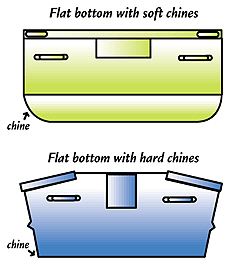Introduction
Have you ever been to a busy marina and looked at the shapes of the different types of boats moored there? Sometimes you can even find boats entirely out of the water, so that you can see the entire hull. You can see from the smooth lines of a sailboat how it is designed to slip through the water.
Sailboat hulls tend to be long and narrow, with a deep keel to keep the boat from tipping when sailing in a strong wind. They cut easily through the water. Their shape helps to reduce drag, or fluid friction, on the boat as it moves through the water. Dinghies and row boats, on the other hand, have flat bottoms for stability in the water (see Figure 1). When powered with a motor, the ride can be rough if there are waves, since the flat bottom tends to slap on top of the waves rather than cut through them.

Figure 1. Examples of hull designs for flat-bottomed boats (Zidock Jr., 1999).
There are many different hull designs used for small boats. The best design for a particular boat depends on the purpose for the boat, for example fishing, sailing, water skiing, transportation, recreation. This project will help you get started on researching different types of boats. It will also show you how to build some boat models and test how easily each one moves through the water.
Terms and Concepts
To do this project, you should do research that enables you to understand the following terms and concepts:
- bow,
- stern,
- drag,
- boat hull shapes:
- flat-bottomed boats,
- vee hulls,
- tunnel vee,
- catamaran,
- tri-hull (or cathedral hull),
- pontoon.
Questions
- From your background research, which hull design do you think will produce the least amount of drag?
- For each hull design, how do you think the drag force will change as the speed of the boat increases?
Bibliography
- This chapter from a boating safety guide introduces boating terminology and design features of different types of boats:
Staff, 2006. "The Boat," Boating Basics Online, Nautical Know How, Inc. [accessed November 27, 2006] http://www.boatingbasicsonline.com/course/boating/3_1.php. - These introductory articles on boat hulls both include profile illustrations for common sport-boat designs:
- Zidock Jr., A., 1999. "Boat Hull Design," Pennsylvania Angler & Boater, 68 (4, July/August) [accessed November 27, 2006 ]http://www.fish.state.pa.us/anglerboater/1999/julaug99/boathull.htm.
- Staff, 2003. "RC Boat Hull Design," R/C Airplane World [accessed November 27, 2006] http://www.rc-airplane-world.com/boat-hull-design.html.
- Advanced students may want to experiment with hull design software to test hypotheses before making physical models. Here is a freely available software package:
Materials and Equipment
To do this experiment you will need the following materials and equipment:
- soft wood (e.g., pine) for making boat hulls (2 × 4 lumber is a good starting material),
- small nails, brads, or cup hooks for fastening string to boat hulls,
- wood carving tools for cutting and shaping the wood,
- 1–2 meter length of 4" plastic gutter,
- plastic gutter endpieces,
- garden hose,
- water source,
- string,
- spring scale (250 g range should work well, available online from Edmund Scientifics, part number 3001000).
Experimental Procedure
Safety Note: Adult supervision is recommended when working with wood carving tools.
- Do your background research so that you are knowledgeable about the terms, concepts, and questions.
- Construct at least four different boat hull shapes from pine or other soft wood. Use the same overall dimensions (length and width) for each design. So that the boat hulls will fit comfortably in the plastic rain gutter for testing, do not exceed 7.6 cm (3") in width.
- Place a nail or cup hook in the center of the top surface of each boat hull. You will use this for attaching the hull to a spring scale for testing.
- Close off both ends of the rain gutter, but leave a small gap at one end for water outflow. Place the garden hose at the other end, and start water flowing.
- Adjust the flow rate of the hose so that the rain gutter is nearly full, with a steady flow of water.
- To measure the drag produced by each hull design, place the hull in the rain gutter with the bow end facing towards the hose end. Run a loop of string from the nail or hook on the hull to the spring scale. Hold (or attach) the other end of the scale to the inlet end of the gutter.
- For each hull, record the reading on the spring scale. Test all of the hulls at the same flow rate.
No comments:
Post a Comment